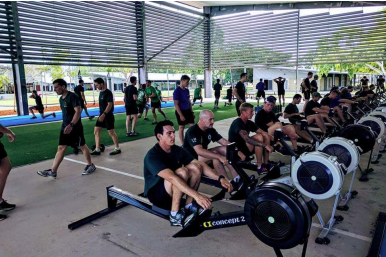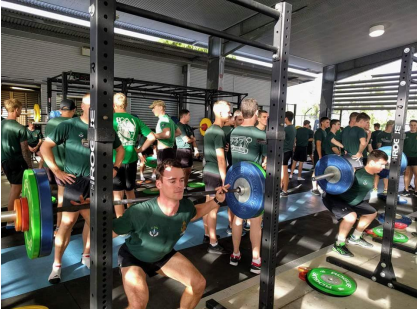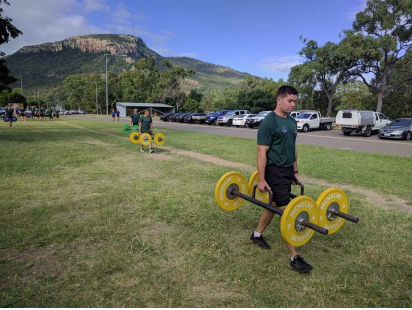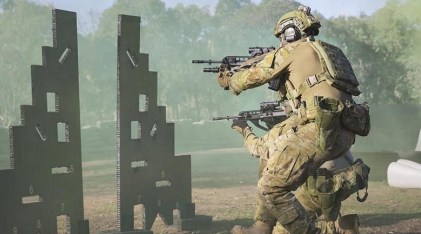'If a program of physical activity isn’t designed to get you stronger or faster or better conditioned by producing a specific stress to which a specific desirable adaptation can occur, you don’t get to call it training. It’s just exercise.' Mark Rippetoe
Soldiers are a unique brand of athlete, but are athletes nonetheless. To optimise human performance on the battlefield, every part of the tactical athlete’s [i] preparation needs to be on point – physical training, nutrition, recovery and education. Indeed, their survival in combat may depend on it. Evidence-based methods increasingly support the need for a holistic training program that advocates a preventative approach to injury management, rehabilitation and research.
The Cove has been a source of some forward-thinking discussion on strength and conditioning since its inception. Lieutenant Calen Thomas made a case for a cultural rationalisation in aerobic endurance training [ii] , as well as for a more networked approach to military strength and conditioning, offering an example of a holistic FORCOMD-driven human performance model [iii]. Major Pete Tarling considered contemporary injury rates in the Australian Army and tendered lessons from the Soviet sports system, making a compelling case for their conceptual application through the Force Generation Cycle [iv]. Captain Nick Alexander offered a valuable tool to Combat Fitness Leaders (CFL) and Physical Training Instructors (PTI) for managing fatigue and injury with the Acute:Chronic Workload Ratio [v]. I have omitted mention of other good think-pieces from some intelligent people, but I maintain that all of them have contributed to a timely and necessary conversation on military strength and conditioning. I do not aim to revisit stepped ground, but merely offer further discussion on tactical athletic performance from a practitioner’s perspective.
My thesis as outlined in this article is simple and comprised of three parts. First, I posit that traditional forms of physical training (PT) programming do not offer optimal physical progression for tactical populations. Second, implementation of a program based on a model of periodisation offers a flexible, customizable tool for unit-level physical training that realises and maximises the benefits of the full spectrum of athletic modalities, fusing them together in a coherent and sustainable system. My third proposition is that the introduction of strength training to unit-level physical training programs has immense benefit to tactical performance and force preservation.
Traditional PT Programming
Generally, a unit-level PT program has been formed on the basis of one of two methods of programming; the first being a ‘randomised’ approach, while the second is a model of linear progression.
Randomized Circuit Training

Random ‘circuit’-focused training will often feature a heavy emphasis on callisthenics and metabolic conditioning. There are several reasons why a randomised approach has persisted as the common model inmost units for some time.
First, advances and investment in strength and conditioning knowledge is a relatively recent evolution for the ADF and other Western militaries. Cultural change can take decades to implement, as those who influence physical training programs and culture were often recipients of this very type of inefficient training. Infantry Battalions have seen a quantum leap forward in the investment and requisition of equipment which makes it possible to train more than a few ‘traditional’ physical modalities like push-ups and weightless running.
The second reason for this persistence is that, quite simply, randomised training is used where a progressive PT routine is absent. It is alluringly simple to train large groups of people, with little equipment and preparation. Even more, it is tempting for commanders to delegate responsibility for small-team physical training to their many enthusiastic, but often under-qualified subordinates. A unit is lucky to have a dedicated PTI, and luckier still to have more than a handful of CFL per sub-unit.
Third, PT is often anecdotal or supports the leader’s strengths. If the Platoon Commander enjoys running, then the Platoon physical regimen will likely feature liberal bouts of it at the expense of other valuable skill sets which may be more useful for employment in close combat.
Unfortunately, for trainees of this program, injury rates are often high, and quantifying progression is difficult. This type of routine is usually born from a lack of PTI supervision, a lack of command direction or focus ('what are we training for?') and a culture of doing ‘hard’ PT. Unfortunately, this ultimately leads to ‘exercising for exercising’s sake’ – performing hard PT to make you tired; not smart PT to make you better. Tactical populations are usually a competitive bunch, who will take no convincing to push each other to extreme fatigue in the interest of contest. In the absence of tangible goals or ‘benchmark’ events, it is easy to mistake the feeling of exhaustion for progress.
By incorrectly training a carelessly blended mixture of techniques, you are essentially training to be ‘good’ at little. Some proponents of this methodology will argue the opposite; that variety leads to improvement in everything. How often have you heard the phrase, 'Keep the body guessing'? For example, advocates of popular circuit training protocols like Crossfit, P90X, F45 or Insanity may claim that they train for every eventuality. Unfortunately, this is not how human physiological systems work. You become better at that which you practice, both metabolically and mechanically. Practising everything essentially makes you better at nothing [vi]. Given the emphasis on PT in the standard unit daily battle rhythm, and its indisputable importance to the close combatant, is it not bizarre to think that physical training could be viewed so differently to every other type of mission-essential training? Consider the irrationality in deploying a Battlegroup to the field with no resources, no plan, and no ‘training level or standard’ to meet and expecting progress.
Linear progression

Where a PTI has significant involvement in a Battalion PT program, this is the model most often used, and is far more beneficial than the ‘random’ approach. It involves a gradual increase in intensity, volume, duration or a combination of the three, before peaking, deloading and repeating. I cite the example of the 6-week PESA preparation program, which incrementally adds distance and weight to the load-carriage before culminating in the PESA testing. Popular linear strength training routines include Mark Rippetoe’s ‘Starting Strength’[vii], or John Sheaffer’s ‘Greyskull Linear Progression’[viii] . However, while both of these are highly-regarded systems for building strength, they do not describe useful methods for the harmonious inclusion of conditioning protocols, an essential requirement for the tactical athlete [ix]. An athlete cannot develop maximum strength, anaerobic endurance and aerobic endurance all at the same time. The greatest performance improvement in any one modality can be achieved only if the tactical athlete concentrates on this type of training for a reasonably long time [x]. Therein rests the problem with linear progression. When attempting to incorporate strength, conditioning and endurance in the same session (often in a circuit fashion, to cater for large groups of people in a rotation), neither is optimised to its full potential. Without boring the reader about Selye’s stress model of General Adaptation Syndrome [xi], one need only appreciate that attempting to combine more than a few skill sets or physical training modalities into a single block of training, or indeed over single sessions, does not generate the appropriate adaptations beyond a few weeks or months before homeostasis is achieved, halting progress. In this sense, a good training plan is simply about finding balance between conflicting demands and eliciting continual progress. Periodisation is a model of training that solves this dilemma.
Block Periodisation

Block periodisation refers to organising your training into specific periods, or ‘blocks’, of time. Each period can have a different length, and each should have a different primary focus. To use an analogy, would you try to learn Spanish, French and Chinese by attending a different lesson each day, or focus on one until you achieve a degree of competence, then move on to the next? Where is the sense in attempting to qualify a vehicle driver while he is conducting his promotion course, compressing both into the single six to eight week period usually afforded to each? Could you consider them well-trained in both? It is simply not optimal to mesh together every physical training technique and call it a ‘balanced’ program. Block periodisation counters this. It takes advantage of the one physiological truth that professional athletes understand –your training should be specific, because your body is. You don’t run long distances to improve your squat – if you need to get better at squatting, then you have to squat. However, trying to improve squatting and running simultaneously usually means average results in both.
Normally, block periodisation is synonymous with words like accumulation, transmutation, and realisation, which refer to the ‘blocks’ of training. The length of each of these blocks is determined by the level and experience of the soldier. Lesser-trained soldiers will experience a higher transfer of training by having longer accumulation phases, whereas soldiers who are quite advanced physically only need to return to an accumulation phase to re-develop their base or retain certain adaptation, otherwise benefiting more from a longer transmutation phase [xii].
Accumulation (or ‘general preparation’) is a block devoted to building general strength and conditioning. This stage won’t necessarily directly affect ‘tactical’ performance in the individual, though it is necessary to lay the foundation to allow progression to more specific factors, such as maximal speed and rate of force development (RFD). Think of this phase as the most ‘general’ type of PT, including standard barbell training, bodyweight routines and aerobic output.
The Transmutation (or ‘specific adaptation’) block follows and is a cycle where general modalities are reduced in favour of more specific training. The general motor skills and technical abilities developed during the accumulation block are evolved and transformed into ‘task-specific readiness’. For example, a strength program with emphasis on lower-limb strength and flexibility in an accumulation phase may ‘transmutate’ powerfully when shifting to a load-carriage and weighted walking routine.
Realisation (‘Competition’ / ‘Peak’) is a short block of training designed to taper for an event, competition, fitness test or operational deployment. The volume is low and the intensity is high, with all superfluous activity removed. Exercise selection is as close to the event conditions as possible. For a tactical athlete preparing for an operational deployment, this will mean ignoring all excess training in favour of the activities they will likely be performing, which may mean wearing of body armour, carrying weapon systems and other equipment and climbing walls and vehicles.
For some, understanding these terms is beneficial. For the soldier, it’s not necessary at all. Instead, you can assign whatever focus you want to a given block. It’s only important to envisage a broad theme of moving along a progressive spectrum from 'general…to specific.' Block periodisation allows the PTI to forecast known operational readiness requirements (such as the Unit’s assumption of Ready Battlegroup responsibilities, or the conduct of the annual PESA), and program backwards to ensure maximal performance.

Suggested Programming
As an example, I propose some variation of the following block periodisation template and principles:
Block 1 (Accumulation)
- Volume – High (up to 500 repetitions per week) [xiii]
- Frequency – Medium(3 – 4 days per week)
- Intensity – Low (65 % – 75 % of training maximum)
Between 3 and 12 weeks of ‘base-building’ and energy system development. Liberal doses of long, slow running, cycling and swimming in the 130 – 150 beats-per-minute (BPM) heart rate (HR) range. This range creates an adaptation in the heart that improves ‘stroke volume’, or the amount of blood and oxygen you’re moving with each beat, which lowers your resting heart rate [xiv]. This provides a solid aerobic foundation for the more intense work to come. There should be regular strength training, focused on full body routines, mastering technique and performed for medium-high volume at lower intensities. Daily focus should be applied to whole-body mobility, range of motion (ROM) and flexibility.
Indicator exercises [xv]:
- Basic Fitness Assessment.
- Army Swim Test.
- Cooper Test.
- Beep Test / Shuttle Run.
- Bench / Squat / Deadlift / Press.
Block 2 (Transmutation)
- Volume – Medium(300 – 400 repetitions per week)
- Frequency – Medium(2 – 3 days per week)
- Intensity – Medium(75% – 85% of training maximum)
Between 3 and 12 weeks of increased intensity and lower volume training. This would involve 400m / 800m / 1200 m interval training, without weight initially, focusing on performance in the Army’s Basic Fitness Assessment and foundation training for the weighted Special Forces 3200m test. The weight used in the strength sessions increase while the repetitions decrease (higher intensity, lower volume), and emphasis is added on plyometric and ballistic movement, such as jumping, throwing, sprinting and sled pushing.
Indicator exercises:
- 3.2km run (non-weighted, weighted).
- Special Forces or Amphibious Swim Test.
- Combat Arms PESA.
- Box Jump / Medicine Ball Throw.
- Bench / Squat / Deadlift / Press.
Block 3 (Realization)
- Volume – Low (100 – 200 repetitions per week)
- Frequency – Medium(2 – 3 days per week)
- Intensity – High (85% - 95% of training maximum)
Between 3 and 12 weeks of event-specific training. If not training for a test, event or operational deployment, then ‘battle’ PT should be the focus – firing and moving, rope climbing, weighted marching, loaded carries, weighted running, and maximal aerobic speed [xvi] (MAS) training. Much like a professional athlete gets highly specific in the weeks leading up to their event, these tactical abilities should be tailored in the ‘peaking’ block of any training program.
- Corps-specific PESA.
- Unit Commanding Officer’s Fitness Test (COFT).
- Operational deployment.
Block 4 (Deload)
This block sees up to 2 weeks of deloading and recovery and would include swimming, slow jogging at race distance (if your target was a 2400m or 3200m test, for example), deep tissue massage, foam rolling and stretching (dynamic and static). There is no reason why the strength routine could not be maintained, albeit at reduced volume, and there is great benefit in employing full range of motion (ROM) work in the primary exercises. The deloading block allows for a period of supercompensation [xvii], capitalising on progression from the previous cycles, which can be built upon for a subsequent block of training. You will have the option to return to the accumulation block, which may be appropriate following a Christmas Reduced Tempo Period (RTP), or an extended deployment in the field, or return to a transmutation block and build on acquired skill sets.
Conclusion
Admittedly, the reality is invariably never this simple. In fact, with the demands of tempo in most units, when do you ever have an uninterrupted block of reasonable length to conduct a full PT program? In this sense, it may be worthwhile to program short 3-week blocks with undulating progression, which is suitably adaptable to unit tempo and unforeseen circumstances. Nevertheless, tempo should not be an excuse to conduct haphazard circuit training. By overlaying the principles prescribed in the above template with the unit training program, clear guidance is given to Combat Fitness Leaders for the meaningful physical development of our tactical athletes. If your unit is guilty of conducting randomized and aimless circuit training, question the goal of that PT, if there even is one. We train all other aspects of soldiering with a clear plan. Why not fitness?
In Part 2, we’ll explore why strength training, in particular, is essential for improving lethality (tactical performance) and survivability (injury prevention and force preservation).
Suggested Further Study:
These easily-digestible resources expand on the central themes presented above:
1. Viada, A. The Hybrid Athlete, Juggernaut Training Systems, 2015
2. Wendler, J. 531 Forever: Simple and Effective Programming for Size, Speed and Strength, (Wendler LLC: 2017)
3. Wenning, M. Programming for Tactical Populations, presentation to the National Strength and Conditioning Association –Tactical Strength and Conditioning Conference, 2014









